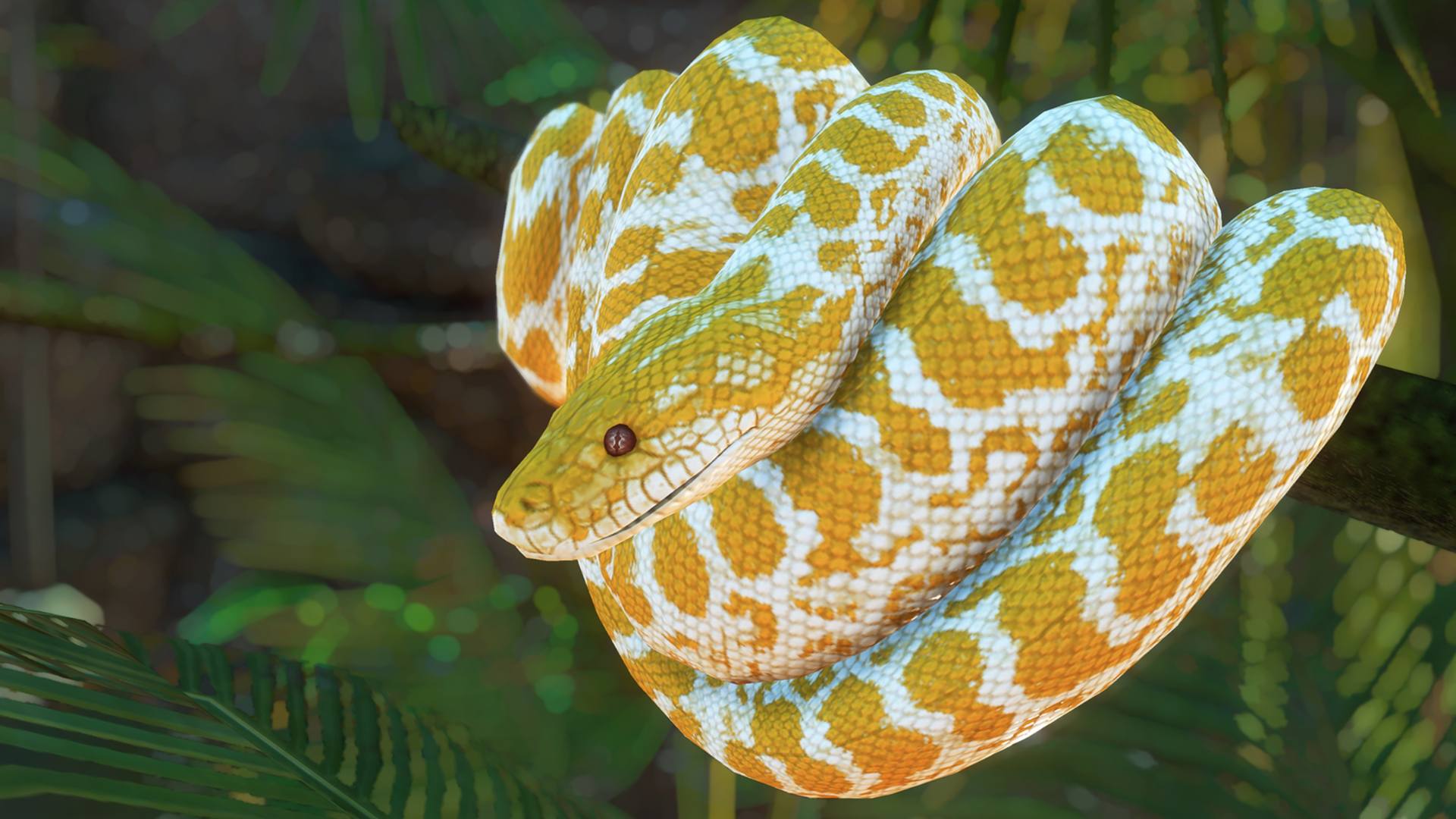In India, traditional medicine seems to cure most snake bites. But most snakes there aren’t venomous. When they are, that’s a different story.

A non-venomous Burmese python coils around a tree branch. The snake is common in the Northeast of India. (Credit: MrrobsonnBR from pixabay)
In a village near Kaziranga, Assam, a 21-year-old man watched helplessly as his friend’s wife died. The a young mother had been bit by a banded krait, one of India’s deadliest snakes.
The morning she was bitten, her family sought the help of a traditional healer. They had no access to healthcare services anywhere close to where they lived.
The healer they met applied a tourniquet — a tight band to constrict blood flow — on her hand near the bite. He also made a cut close to the bite to drain the venom and applied a herbal paste. A few hours later, the hand began to swell and hurt so immensely, they had to remove the tourniquet.
She began to speak gibberish and did not leave the bed. Seeing her condition worsen, they called for an ambulance, but the woman passed away even before they could reach a hospital which was two hours away.
Like many in his village, the young man, who asked that his name not be used to protect his position in the community, had believed traditional remedies were sufficient.
“This was so confusing to me because it was the norm in our village to visit the traditional healer the minute someone had a snakebite and almost everyone got better,” he said. “Only two people have died so far, including my friend’s wife. The hospital is really far away and we don’t anyway go there if there was not a huge issue.”
Medicine at hand or a trip to a hospital
The woman’s death was not an isolated incident. All over Southeast Asia, Latin America and parts of Africa, people have turned to traditional medicine over modern medicine to treat snake bites, a preference that can be fatal.
The problem, said Dr. Sushil Mathew John, a public health physician from Christian Medical College in the city of Vellore, is that most snake bites will heal without antivenom.
“More than 90% of snakes in India, for example, are non-venomous and not all snake bites from venomous snakes also end up having injected venom,” John said. “So most of the time, the treatment given by traditional healers are sufficient because they don’t have any venom in their system and the patients survive.”
This, John said, makes people believe that it is something a traditional medicine can cure.
“This ends up with disastrous consequences for the almost 5% of people who get bitten by venomous snakes and get injected by the venom,” John said.
Can hospitals work with traditional healers?
Now, many health professionals are working to train traditional healers to spot when people need to seek antivenom treatment so they can steer these patients to medical centers.
According to a study by researchers in India and the United States and published in 2025, in villages of Tamil Nadu, a state in South India, traditional healers are the first point of contact for about 64% of the snakebite victims.
Shuma Banik, a global health expert working in Oxford, England said there are many reasons people turn to traditional medicine as a cure for snakebite. Banik hails from Karimganj, a village in rural Assam with little access to health services. Banik has seen her own relatives seek healthcare from traditional healers for snakebite.
“Firstly, there is a lot of cultural and religious significance awarded to snakes in various parts of India, and across the world,” Banik said. “People pray to snakes, offer milk to them and believe that snakebites are divine will. Given this belief, it is easy for them to then believe that the same areas that offer cultural engagement with snakes as deities, such as temples and traditional healers will be able to offer them treatment for snakebites too.”
This sentiment is echoed by Dr. Jose Maria Gutierrez, a professor emeritus at the University of Costa Rica. “In Latin America, people believe that snakebites are associated with sorcery,” Gutierrez said. “This metaphysical interpretation of snakebite is also one of the reasons that they seek care from traditional healers.”
But more than this cultural aspect, there is also the problem of healthcare access which significantly affects where the patients go when they get bitten by a snake.
The cost of healthcare
According to the 2025 study of villagers in Tamil Nadu, the lack of buses and ambulances to the village was a significant reason why people ended up reaching traditional healers first — who were available close by and could be reached by walking.
There is also the significant cost of healthcare. Traditional healers are cheaper to access than public hospitals. To go to a public hospital, which is free, requires long distance travel, loss of daily wages and the cost of antivenom from private pharmacies because the public hospitals cannot stock enough of it to meet demand.
Gutierrez said you can see this contrast elsewhere. In Costa Rica, for example, most people seek care for snakebite from the public health system because they are aware that antivenom and treatment will be available to them free of cost across all levels of the health system.
But in other areas such as various parts of Africa and Latin America, the lack of access to this kind of healthcare makes people seek traditional healers first.
Even in areas such as parts of Brazil where snakebite treatment most often means rituals, chants and prayers, it is worthy to note that once antivenom was made easy to get, people preferred the antivenom.
Training traditional healers
Gutierrez said it is important to differentiate traditional medicine from popular medicine or folk remedies.
“Traditional medicine systems are our cultural heritage and they deserve respect and preservation unless any of the methods used are proven harmful,” Gutierrez said. “However, not many traditional medicine systems or texts speak about the interventions such as applying a tourniquet or cutting to release venom or using suction devices or sucking the venom with the mouth. These are popularly-practiced remedies which do not align with traditional medicine as well.”
The 2025 study, found that 35% of traditional healers were self taught and around 65% were trained by their fathers.
Secondly, many plant extracts which are applied to the wound or given for the patient to drink when studied in laboratories were found to be effective against some snake venoms.
Gutierrez said that more studies should be done to test whether traditional medicines can work isolating the active ingredients and applying appropriate evidence-based tests, “Instead of saying that things do not work, we must ensure that due scientific process is used to evaluate the plant extracts which are suggested both pre-/clinically and clinically, to ensure efficacy and safety,” he said.
Combining the traditional with science
There are aspects of snakebite which can be uniquely dealt with by traditional healers where modern medicine fails. “When someone considers snakebite a curse, just medical treatment will not give them relief,” he said. “A traditional healer is in a unique place where they can give spiritual and mental relief to the patient who believes themselves cursed by using their practices,” he says.
Banik said that there is value in integrating the services of traditional healers within the modern medicine system.
Historically, when smallpox raged through India and the government was trying to vaccinate the people who were unsure about it, they enlisted the help of local traditional healers and used temples and other places of community engagement to set up vaccination centres. This helped the community acceptability of the vaccines, she says.
This indicates that traditional healers are often respected members of their communities who could teach people about snake bites and mobilise them to seek antivenom and other modern treatments.
Gutierrez said that such a project is being conducted in several parts of Latin America. There, traditional healers are asked to also accompany patients to a health centre where the antivenom is being administered. “This improves the trust of the patient in the health system when they are accompanied by someone they respect,” he said.
Banik and Gutierrez both say that there needs to be dialogue between the public health system and the traditional healers to ensure early referral of patients to hospitals. Teaching traditional healers to identify snakebite, educating them and preventing harmful first aid measures and empowering them to refer early are all important ways to ensure that good treatment is made available to the patient.
And then once the biomedical management of snakebite is over and the patient returns to the community, the traditional healer could then help mitigate any mental health consequences such as PTSD or bite-anxiety developed by patients, to offer spiritual relief and reassurance to their metaphysical worries about snakebite and successfully help them in reintegration to their jobs and communities at large.
Whether modern health providers like it or not, people are going to go to traditional healers for snakebite treatment. It would be better to integrate them into the system and work together as a team towards the common goal of effectively preventing snakebite deaths instead of being at odds.
Questions to consider:
1. Why do many people in India turn to traditional healers when they have medical needs?
2. How can healthcare be improved in the rural areas of India?
3. If you were bitten by a snake what would you do?

Dr. Christianez Ratna Kiruba is an internal medicine physician from India who is a patient rights advocate and is passionate about analysing public health issues through a gender lens. She is currently a fellow in the University of Toronto’s Dalla Lana Fellowship in Journalism and Health Impact.
